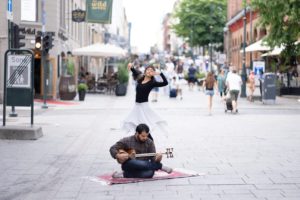Iranian Dancers Outside: Exploring contemporary paths in Oslo and San Francisco - Vancouver Ballet Society
- Home
- Features 2020 - 2023
- Iranian Dancers Outside: Exploring contemporary paths in Oslo and San Francisco

By Mahsa Hojjati
Iranian diaspora children are frequently asked: “Where is better: Iran or Khārej (Outside)?” A question as difficult to answer as: “Who do you love more: Māmān or Bābā?” The benefits of living Outside cannot bridge the distance from family, friends, and the best food on the planet. Of course restrictions are suffocating and injustice is unacceptable — whether Inside or Outside. Just as not all is rosy abroad, not all is darkness at home.
One source of light in Iran is the world of dance, encompassing regional folk dances as well as popular forms that have been pushed to the underground in the past 40 years. This world of movement is still alive and kicking at home, and also stretches beyond borders. Born and raised in Iran and formally trained in the diaspora, Hediyeh Azma and Aisan Hoss use contemporary Iranian dance to explore their deepest concerns as they navigate the bittersweet terrain of immigrant life.
Hediyeh Azma
At 11, Hediyeh Azma dreamed of studying with Farzaneh Kaboli, a principal dancer of the former National Folklore Organization and a renowned choreographer after the revolution. Her dream materialized into 13 years of classes with Sepideh Bakhtiari, an instructor trained by Kaboli, in a style that was alternately called Iranian traditional, classical or national dance before the revolution, and is still referred to by multiple names. Azma also formed part of a contemporary dance working group who met periodically to practice together and to share readings on dance.
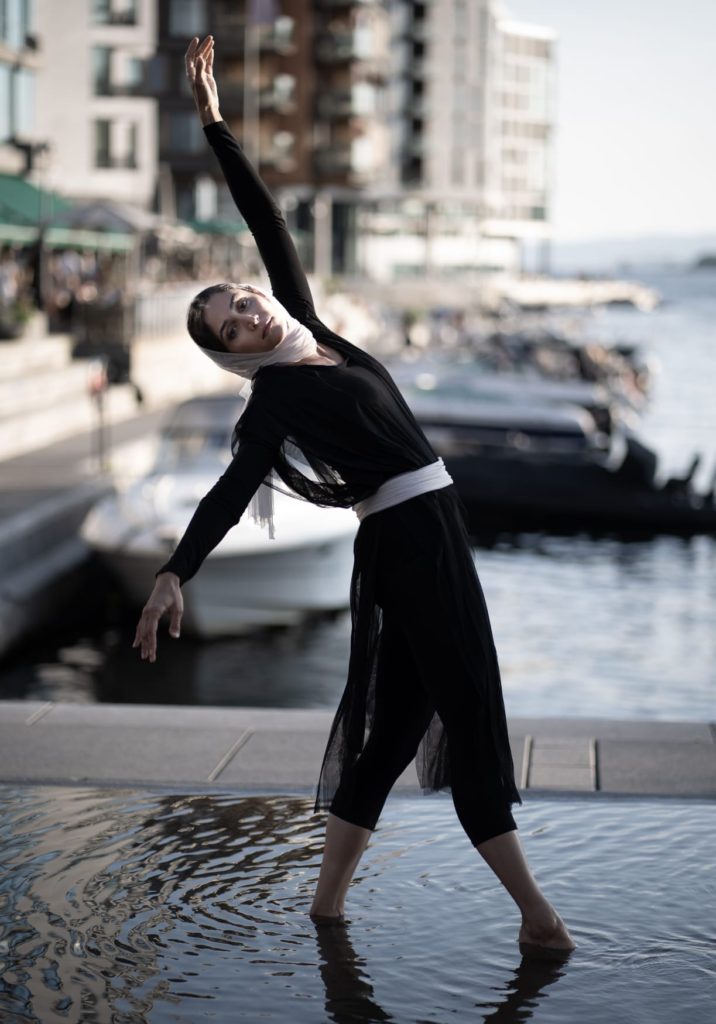
While her early training was led by narrative dance forms and musicality, social issues are the seeds for her choreographic process. The Contrast (2012) portrayed a couple’s transition from happiness to routine and eventually to the death of spirit, while The Doubt (2013) conveyed the inner struggle of women who feel forced to bury their aspirations.
Despite the post-revolution prohibition of dance in public spaces in Iran, presentations are occasionally permitted if they are considered theatre or ritual by authorities. Thus, Azma’s early choreographies were performed, for the Point Festival in Arak University, under the rubric of physical theatre.
In 2016, Azma immigrated to Norway, and two years later became the first Iranian to complete an MFA in Dance Knowledge, Practice and Heritage through the Choreomundus Consortium organized by four European universities. During a semester at the University of Szeged in Hungary, Azma collaborated on an extracurricular project titled Imkaan (Possibility, 2017) with photographer Sumedha Bhattacharyya, which explored the feeling of in-betweenness familiar to immigrants experiencing cultural transition.
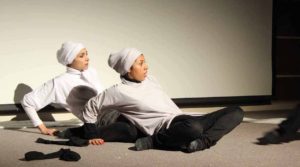
Now a freelance choreographer based in Oslo, Azma’s current work-in-progress, The One From Far, is a collaboration with fellow Iranian immigrant artists, including dramaturg Hoda Arbabi. The work is an adaptation of Henrik Ibsen’s play Lady from the Sea. Azma relates to Ibsen’s character Ellida, who chose a life far from the sea she loves. “I find myself living in a country which gives me security,” she says, “but has distanced me from everything I love in my homeland.”
Azma has also been channelling her energies into Recite the City, a collaboration with Iranian Ali Aalaei, who composed the music for tār (a double-bowled Iranian lute), which he played live during performances from July to October 2021. Much movement was improvised, in relationship to audience participation and to each location. Recite the City followed Azma’s quest for personal connection to emblematic Norwegian sites such as Karl Johans Gate (the main street in Oslo), Akershus Fortress and Aker Brygge Marina.
Aisan Hoss
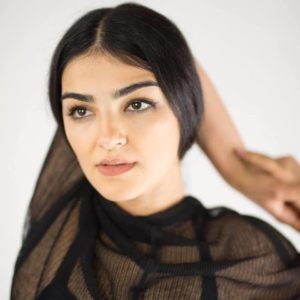
As a young child Aisan Hoss loved dancing to the sounds of the evening azān (the call to prayer) before breaking the fast of Ramadan. Her grandmother would try to convince her to sit still, but Hoss’ expressions of joy to the music of prayer were unstoppable. Her dancing triumphed over prayer etiquette.
With time, her love of movement pulled her to train with Haideh Kishipour, the director of Shiftegān-e Del, a dance-theatre company performing for women-only audiences in venues such as Vahdat Hall in Tehran. In a recent interview through Zoom, Hoss reminisced about the years she was a member of the group: those days of eight-hour rehearsals in a basement studio without air conditioning formed, she said, “one of the best times of my life.”
Years later, at Trinity Laban Conservatoire of Music and Dance in London, she valued the opportunity for immersion in technique. However, as the only Muslim woman in her program, it was not easy to make friends or adapt to British culture. Hoss speaks fondly of Rosemary Brandt, a senior lecturer at Trinity Laban, who, she said, “gave me the courage to continue by reminding me I had something special that I needed to show: the unique heritage of movement languages from another country.” In addition to Hoss’ early training in traditional Iranian dance forms, she also grew up learning regional Azerbaijani dances in family festivities.
Hoss went on to pursue an MFA at Mills College in Oakland, California, where she had the opportunity to look inwards, discover and create. She came to realize that western audiences often had distorted views of Iranian dances. Decades of viewing melting pot versions of Persian dance, replete with dazzling costumes in spectacles thick with Orientalism, had led event organizers to deem such fantasies more authentic than what feels and looks like home to Iranians.
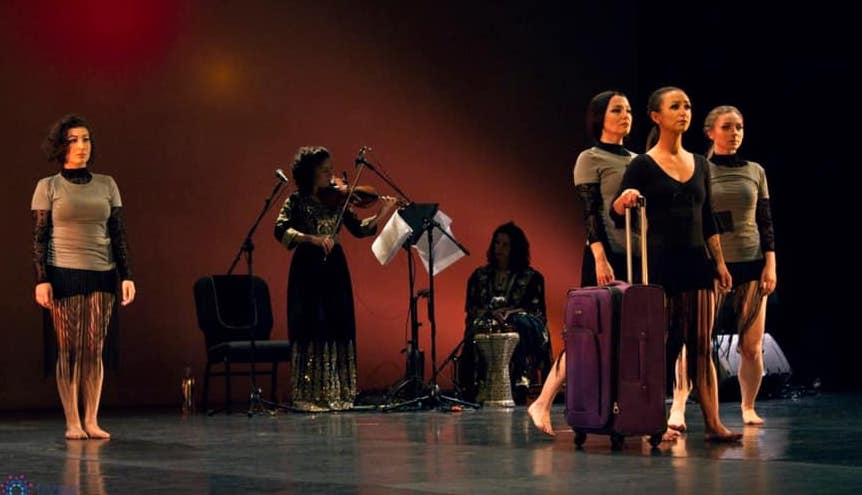
Preferring the path of contemporary expression, in her choreography Hoss started exploring opposite gestures midway through traditional movements in efforts to deconstruct what she knew. “My approach to contemporary dance is very Iranian,” she said. “I am going back to what I experienced in Iran as a child.”
Research gives strength to her choreographic processes. In preparation for The Pleasant Pain (2017), Hoss interviewed 27 recent immigrants from Iran in order to explore shared experiences such as the feeling of being lost.
Mastoureh Jafarzadeh, an Iranian member of Aisan Hoss and Dancers, founded in 2016 in San Francisco, relates to the themes Hoss brings to the stage, as in Nuance: An Immigration Story (2019), which challenges misconceptions regarding Muslim women. For the non-Iranian dancers in the group, though, cultural explanations are usually necessary. Yet, Hoss says, “My dancers love working on new projects because I cook for them; we laugh and cry together.” As they strive to understand and transmit the deep emotions Hoss wants to share in her work, she also tries to understand her dancers’ realities. This mutual understanding of each other’s truths strengthens their connection with audiences.
Aisan Hoss’ next project aims to explore what it means to be homeless, whether for an immigrant far from their homeland or an American-born citizen sleeping on the streets in the United States.
